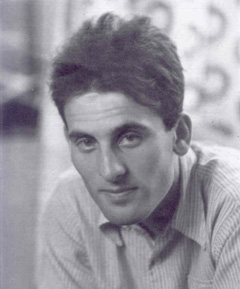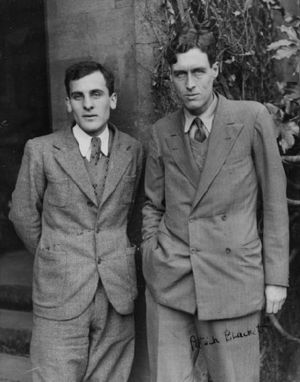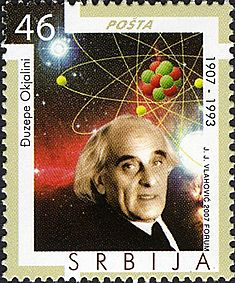Giuseppe Occhialini facts for kids
Quick facts for kids
Giuseppe Occhialini
|
|
|---|---|
 |
|
| Born | 5 December 1907 |
| Died | 30 December 1993 (aged 86) Paris, France
|
| Known for | |
| Scientific career | |
| Doctoral advisor | Bruno Rossi |

Giuseppe Paolo Stanislao "Beppo" Occhialini (born December 5, 1907 – died December 30, 1993) was a famous Italian physicist. He helped discover important particles like the positron and the pion.
He worked with other scientists, including César Lattes and Cecil Frank Powell. Powell later won the Nobel Prize in Physics for their work on the pion. An X-ray satellite was even named BeppoSAX in his honor.
Contents
About Giuseppe Occhialini
Giuseppe's father, Raffaele Augusto Occhialini, was also a physicist. Giuseppe finished his studies in Florence in 1929.
In 1932, he helped discover the positron at the Cavendish Laboratory in Cambridge. He worked with Patrick Blackett, using special tools called cloud chambers to see tiny particles.
He went back to Italy in 1934. However, the political situation there was difficult. So, from 1937 to 1944, he worked in Brazil at the University of São Paulo.
In 1944, he returned to England. He joined the Wills Physics Laboratory in Bristol to study cosmic rays.
Discovering the Pion
In 1947, while in Bristol, he helped discover the pion. This was a big step in understanding how particles work. He worked with César Lattes, Cecil Frank Powell, and Hugh Muirhead.
They used special photographic plates to see the paths of these tiny particles. Cecil Frank Powell won the Nobel Prize in Physics in 1950 for this important discovery.
Giuseppe Occhialini returned to Italy in 1950. He taught physics first in Genoa and then at the University of Milan starting in 1952.
He continued his research on cosmic rays. He also helped create the European Space Agency. This agency helps explore space.
Awards and Recognitions
Giuseppe Occhialini received many honors for his work:
- The Physics Department at the University of Milan-Bicocca is named after him.
- The SAX satellite, which studies gamma rays, was renamed BeppoSAX. "Beppo" was his nickname.
- An asteroid, 20081 Occhialini, was named in his honor.
- In 1949, he received the National Prize of the President of the Republic.
- He was elected to important scientific groups, like the American Philosophical Society in 1975.
- In 1979, he won the Wolf Prize for physics, a very important award.
- In 2004, a foundation was created in his name, the "Foundation Giuseppe Occhialini." It helps teach physics to high school students.
- In 2007, the Italian Physical Society created the Occhialini Prize to remember him.
- In 2009, a square in Milan was named after him. This was the same area where he taught physics.
Personal Life
Beppo Occhialini loved climbing mountains. During World War II, he was in Brazil. He became an official mountain guide there. There is even a mountain peak called "Pico Occhialini" in the Itatiaia National Park.
See also
 In Spanish: Giuseppe Occhialini para niños
In Spanish: Giuseppe Occhialini para niños




